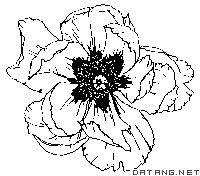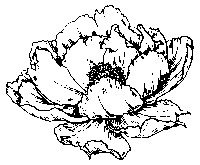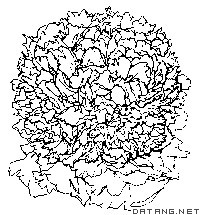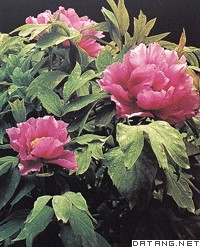1) peony and pear wine


牡丹梨酒
2) Mudan nutritional wine


牡丹营养酒
1.
The intrinsic marketing advantages and disadvantages and the extrinsic marketing opportunities and challenges for Mudan nutritional wine were analyzed by the use of SWOT analysis matrix.
运用SWOT分析矩阵,对菏泽市牡丹营养酒营销内部环境的优劣势以及外部环境所面临的机遇和挑战进行分析。
3) peony
[英]['pi:əni] [美]['piənɪ]


牡丹
1.
Analysis of the application of the form beauty of peony pattern in the folk clothes;


牡丹纹样在民间服饰中的形式美
2.
Study on method of measuring potassium content in peony leaf by distilled water at room tempreture flame spectrometry;
水浸提制备待测液火焰光度法测定牡丹叶中钾含量的方法研究
3.
Study on Biological Characters of the Pathogens of Root Rot Disease and Its Control from Peony;
垫江牡丹根腐病病原菌的生物学特性及其防治
4) Tree Peony


牡丹
1.
Effects of browning antagonists on antibrowning,growth and multiplication of tissue culture of tree peony;
防褐剂对牡丹组培褐化发生、组培苗生长和增殖的作用
2.
Phylogenetic relationship of dwarf tree peony cultivars by AFLP analysis.;


牡丹矮化品种亲缘关系的AFLP分析
3.
Control of tree peony root rot using 6 species of biocontrol fungi and bacteria;


6种生防真菌、细菌防治牡丹根腐病的研究
5) tree-peony


牡丹
1.
AM fungi diversity in the main tree-peony cultivation areas in China;


我国洛阳与菏泽牡丹主栽园区AM真菌多样性研究
2.
Natural Infection Percentage of Arbuscular Mycorrhizal in Chinese Tree-peony;


牡丹AM菌根菌自然侵染率的调查
3.
After investigated all the main tree-peony production areas,the authors found many problems on Chinese tree-peony,such as resources protection,breed-ing,variety structure,technologies of cultiva-tion and conservation,etc.
我国牡丹在发展过程中存在资源流失、市场混乱、产品结构不合理、栽培管理技术落后、基础和应用研究薄弱等多方面的问题。
6) Paeonia suffruticosa Andr


牡丹
1.
Comparison of Photosynthetic Characteristics Between Potted and Field Paeonia suffruticosa Andr.;
盆栽和地栽牡丹光合特性的比较
2.
Influences of Cold-storage Method on the Growth and Development of "Ming Xing" Paeonia suffruticosa Andr;
冷藏方式对“明星”牡丹生长发育的影响
3.
Anatomical Observation on Paeonia suffruticosa Andr.and Paeonia lactiflora Pall.Based on Phytomorphology of Stem and Leaf;
芍药和牡丹部分品种茎叶器官的解剖学观察比较
补充资料:牡丹
| 牡丹 Paeonia suffruticosa;peony 毛茛科芍药属落叶灌木。原产中国的传统名花。又称木芍药、洛阳花、鹿韭等。花大而多变,色彩艳丽,富丽堂皇,被誉为花中之王。
秦汉时期《神农本草经》中已有以牡丹根皮入药的记载。南北朝时始栽供观赏;至隋已成奇花。唐时牡丹为皇宫珍品,开元年间长安栽培很盛,且育出许多品种。北宋时牡丹栽培中心自长安移至洛阳,号称"洛阳牡丹甲天下"。明代栽培中心又自洛阳移至安徽亳州。约在明嘉庆、万历年间山东曹州菏泽牡丹兴起,至清代即取代亳州而在全国名列前茅。牡丹约于8世纪时传至日本,后育成许多品种。1787 年传入英国。此后辗转流传,成为世界性名花。 牡丹具深根性肉质根。株高0.5~2米。枝多而粗壮。小叶阔卵形至卵状长圆形,先端2~5裂,背面具白粉。花单生枝顶,花瓣5~10,雄蕊多数 。原种花红紫色,栽培品种则多种颜色,并形成多种花型。春末开花。蓇葖果。种子球形,黑色,有光泽 。牡丹品种繁多 , 迄今尚无统一的分类方法。一般可按花色分为白、黄、粉、红、紫、墨(暗紫色)、雪青(莲青)、绿色等品种;按花期分为早花、 中花、 晚花品种。中国古时还按花型分为多叶与千叶两类。近代中国的分类系统依据雄蕊、雌蕊的瓣化将牡丹分为3类12型( 见图 )。主要分布在中国西北部的甘肃、陕西、山西、四川、河南等山区。性喜阳光充足 、干燥温凉 、夏无高温 ,冬不甚寒之地。要求排水良好、中性至微碱性(pH7.0~7.5)的深厚壤土或富含腐殖质的粘质壤土 。分株 、压条 、嫁接或播种繁殖均可。主要病害有叶斑病、紫纹羽病等。牡丹雍容华贵,花大叶茂,适于庭院种植或花坛布置,可丛栽,也可孤植或盆栽。如成片群配以山石道路 ,则可成为牡丹园 。根皮可加工成中药“丹皮”,有镇静作用。
|
说明:补充资料仅用于学习参考,请勿用于其它任何用途。
参考词条



